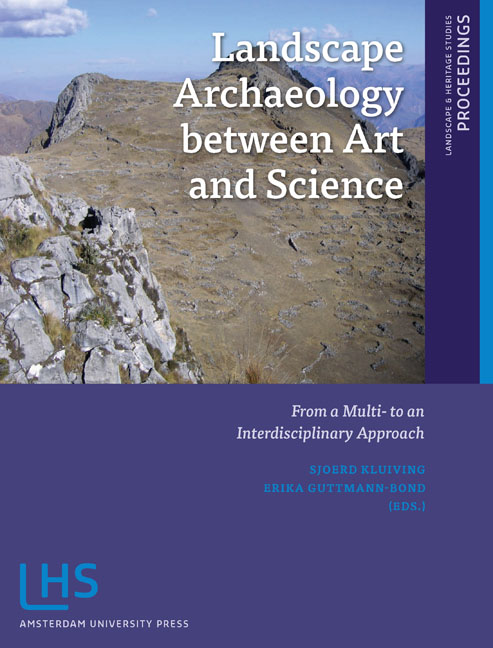Book contents
- Frontmatter
- Contents
- Preface
- Introduction: LAC2010: First International Landscape Archaeology Conference
- THEME 1 HOW DID LANDSCAPE CHANGE?
- THEME II IMPROVING TEMPORAL, CHRONOLOGICAL AND TRANSFORMATIONAL FRAMEWORKS
- THEME III LINKING LANDSCAPES OF LOWLANDS TO MOUNTAINOUS AREAS
- THEME IV APPLYING CONCEPTS OF SCALE
- THEME V NEW DIRECTIONS IN DIGITAL PROSPECTION AND MODELLING TECHNIQUES
- THEME VI HOW WILL LANDSCAPE ARCHAEOLOGY DEVELOP IN THE FUTURE?
- Miscellaneous Endmatter
5.3 - The Occupation of the Antequera Depression (Malaga, Spain) Through the Ist Millennium BC: A Geographical and Archaeological perspective into Romanisation
Published online by Cambridge University Press: 21 January 2021
- Frontmatter
- Contents
- Preface
- Introduction: LAC2010: First International Landscape Archaeology Conference
- THEME 1 HOW DID LANDSCAPE CHANGE?
- THEME II IMPROVING TEMPORAL, CHRONOLOGICAL AND TRANSFORMATIONAL FRAMEWORKS
- THEME III LINKING LANDSCAPES OF LOWLANDS TO MOUNTAINOUS AREAS
- THEME IV APPLYING CONCEPTS OF SCALE
- THEME V NEW DIRECTIONS IN DIGITAL PROSPECTION AND MODELLING TECHNIQUES
- THEME VI HOW WILL LANDSCAPE ARCHAEOLOGY DEVELOP IN THE FUTURE?
- Miscellaneous Endmatter
Summary
ABSTRACT
This article presents a GIS-based approach to investigations of Romanisation in the Antequera Depression, (Málaga, Spain). Two geographic variables, visibility and relative height, were appraised to investigate territoriality and social dynamics during the Iberian and Roman periods. The results indicate both the continuity of Pre-Roman tendencies and the appearance of new trends in settlement, interpreted as the re-orientation of competitive behaviour amongst local communities from warfare and conflict to more symbolic concerns.
KEYWORDS
Antequera Depression, settlement patterns, Geographical Information System, statistics, Iberian period, Roman Republican period
INTRODUCTION
Over the last 20 years, Geographical Information Systems (GIS) have been widely but unevenly applied to archaeological data across Europe (Wagtendonk et al. 2009, 75-78), mostly in Northern Europe. Spanish, and more precisely Andalusian, archaeology has been slower to take advantage of GIS methods. This does not to imply a total lack of GIS application; a number of researchers in the Guadalquivir valley and the campina of Seville have been using GIS to positive effect (e.g. González Acuña 2001; Keay et al. 2001).
An insight into the development of human occupation in the Pre-Roman and Roman periods in Central Andalusia is considered invaluable due to the central position of the Antequera Depression, which has served as a natural crossroad since prehistoric times. These factors are crucial for gaining a better understanding of the process of Romanisation in Andalusia, as well as an insight into the changing territorial organisation of the area during a historically dynamic period in the Mediterranean basin. In working towards this improved understanding, well-established computing and quantitative methodologies were applied to the Antequera Depression, an area in which spatial analysis has not been previously carried out.
GEOGRAPHY AND ARCHAEOLOGY OF THE ANTEQUERA DEPRESSION
The significance of the Antequera Depression is hard to interpret without a clear image of its spatial context, i.e. its location in relation to the Andalusian region. Andalusia occupies the southern part of the Iberian Peninsula, having an area of 87,268 km2. Its topography is diverse, resulting in varied ecological niches, from fertile lowlands close to the Guadalquivir River, to the mountainous chain of the Sierras Béticas, which hosts the highest peak in the Iberian Peninsula, and the desert of Tabernas in Almería province.
- Type
- Chapter
- Information
- Landscape Archaeology between Art and ScienceFrom a Multi- to an Interdisciplinary Approach, pp. 339 - 352Publisher: Amsterdam University PressPrint publication year: 2012



